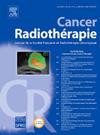中度与超低分割局部乳房放疗:covid-19时代的回顾性研究结果
IF 1.4
4区 医学
Q4 ONCOLOGY
引用次数: 0
摘要
目的在2019冠状病毒病(covid-19)大流行期间,延长老年患者超低分割辅助乳腺放疗的使用。我们比较了在单一放疗中心接受局部放疗的老年乳腺癌患者的有效性和安全性与中度低分割。方法采用常规患者资料进行回顾性分析。纳入标准包括年龄在65岁或以上的女性,患有非转移性乳腺癌,腋窝淋巴结阳性,并在超或中度低分割方案下接受局部放疗。研究结果包括总生存期、无病生存期、晚期正常组织效应和急性毒性。比较分析采用logistic回归和生存分析,并进行协变量调整。结果纳入221例患者,中位年龄72.5岁(四分位间距[IQR]: 67.9 ~ 77.7岁),中位随访36.3个月(IQR: 25.4 ~ 47.8个月)。超、中度低分割方案的总生存率和无病生存率无显著差异(死亡校正风险比[HR]: 0.81, 95%可信区间[CI]: 0.27-2.46, P = 0.712;复发或死亡的校正HR: 0.96, 95% CI: 0.39-2.37, P = 0.923)。虽然超低分割显示中度迟发性乳房水肿增加,但在其他更常见的中度不良事件,如急性皮炎和迟发性同侧臂水肿方面没有观察到显著差异。结论我们的回顾性分析表明,超低分割方案在老年乳腺癌患者局部区域照射中保持可接受的安全性,与中等低分割方案相比,其疗效无显著差异。等待预期的确认。本文章由计算机程序翻译,如有差异,请以英文原文为准。
Moderate versus ultra-hypofractionated locoregional breast radiotherapy: Results of a retrospective study during the covid-19 era
Purpose
The use of ultra hypofractionated adjuvant breast radiotherapy for elderly patients was extended during the covid-19 pandemic. We compared its efficacy and safety versus moderate hypofractionation in elderly patients with breast cancer receiving locoregional radiotherapy at a single radiotherapy centre.
Methods
This retrospective analysis utilized routine patient data. Inclusion criteria comprised women aged 65 years or older with non-metastatic breast cancer, positive axillary nodes, and treated with locoregional radiotherapy following the ultra or moderate hypofractionation protocols. Outcomes studied included overall survival, disease-free survival, late normal tissue effects, and acute toxicity. Comparative analysis employed logistic regression and survival analysis with covariate adjustments.
Results
Two hundred and twenty-one patients were included, with a median age of 72.5 years (interquartile range [IQR]: 67.9–77.7 years) and a median follow-up of 36.3 months (IQR: 25.4–47.8 months). No significant differences were found in overall and disease-free survival rates between ultra and moderate hypofractionation protocols (adjusted hazard ratio [HR] for death: 0.81, 95 % confidence interval [CI]: 0.27–2.46, P = 0.712; adjusted HR for relapse or death: 0.96, 95 % CI: 0.39–2.37, P = 0.923). Although ultra-hypofractionation showed an increase in moderate late-onset breast oedema, no significant differences were observed regarding other more common moderate adverse events, such as acute dermatitis and late-onset homolateral arm oedema.
Conclusion
Our retrospective analysis suggests that the ultra-hypofractionation protocol for locoregional irradiation in elderly patients with breast cancer maintains an acceptable safety profile and shows no significant difference in efficacy compared to the moderate hypofractionation schedule. Prospective confirmation is awaited.
求助全文
通过发布文献求助,成功后即可免费获取论文全文。
去求助
来源期刊

Cancer Radiotherapie
医学-核医学
CiteScore
2.20
自引率
23.10%
发文量
129
审稿时长
63 days
期刊介绍:
Cancer/radiothérapie se veut d''abord et avant tout un organe francophone de publication des travaux de recherche en radiothérapie. La revue a pour objectif de diffuser les informations majeures sur les travaux de recherche en cancérologie et tout ce qui touche de près ou de loin au traitement du cancer par les radiations : technologie, radiophysique, radiobiologie et radiothérapie clinique.
 求助内容:
求助内容: 应助结果提醒方式:
应助结果提醒方式:


